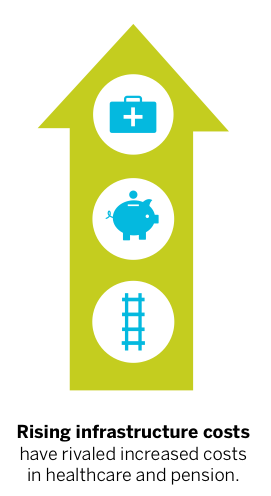LIVING CITIES
Trend 2: Inadequate Infrastructure
 Failing infrastructure is inhibiting economic growth, sustainability and overall mobility of goods, people, and information.
Failing infrastructure is inhibiting economic growth, sustainability and overall mobility of goods, people, and information.
During the 19th century, the industrialization of the U.S. economy and the expansion of railroads led to increased urbanization across the country. As cities began to grow, and people faced difficult and often unsanitary living conditions, local governments responded by digging sewers, creating water systems, paving roads, and providing public transportation. The development of a comprehensive infrastructure system made it easier for people to live in densely populated places, and allowed cities to expand and the country to prosper. During the 1950s, there was another spike in the country’s infrastructure with the construction of the interstate highway system, this time enabling people to move beyond the urban core. While the highway system was viewed as great progress, this investment ushered in an era of infrastructure policy heavily focused on expanding and maintaining these highways, regardless of the country’s actual infrastructure needs.
Today, as gas prices continue to rise, and our water, electric, and transportation systems continue to age, we must adopt a modern view of urban infrastructure that considers the real needs of city residents.
Cities are facing multiple infrastructure problems with limited resources.
While some cities are considering their various infrastructure needs, they are often doing so in silos. It makes no sense to dig up streets to lay fiber and then do it again to expand the area of permeable pavements. This might be called the “dig once” principle. There is real benefit to be achieved by breaking silos of funding and planning and integrating transportation, broadband and water investments.
Cities are facing fiscal pressure and aging assets.
According to a survey conducted by the National League of Cities, rising infrastructure costs – including water, electric, sewer, and transportation – are the fourth most common driver of increased costs for cities. In the same survey, over half of cities questioned say they report more than 50 burst water mains annually. In addition, in many cities, bus and rail assets are under maintained, contributing to the fiscal pressure cities will face in the years ahead. While rail and bus have similar capacity to carry passengers across US cities, many cities focus on maintaining and expanding rail, despite the fact that it is five times more costly than buses.
Strains in the transportation system will continue to have a disproportionate impact on low-income people, who depend on public transportation for basic mobility.
First, low-income transit riders tend to live further from the urban core, resulting in less access to transportation. As a result, low-income people have even higher transit wait times as they are generally unable to substitute public transit with more convenient options. Further, there is an underinvestment in transportation in low-income areas, resulting in poorer quality transportation. This impacts employment prospects, access to services, and inhibits social mobility. Low-income shift workers are dispropor- tionately affected by these longer wait times as irregular schedules can impact their work schedules and livelihood.
Read full report (PDF) here: State of the City
About Living Cities
www.livingcities.org
“Founded in 1991, Living Cities is an innovative collaborative of 22 of the world’s largest foundations and financial institutions. In nearly 20 years Living Cities members have collectively invested almost $1 billion, helping shape federal funding programs, redirecting public and private resources, and helping communities to build homes, stores, schools, community facilities and more. However, our members are not simply funders. They shape our work and priorities by participating on the Living Cities Board of Directors, four standing committees and three working groups. In sum, our members contribute the time of 80-plus expert program staff toward improving the lives of low-income people and the cities where they live.”
Tags: 5 Trends Impacting America's Cities, aging assets, Inadequate Infrastructure, Living Cities, State of the City







 RSS Feed
RSS Feed